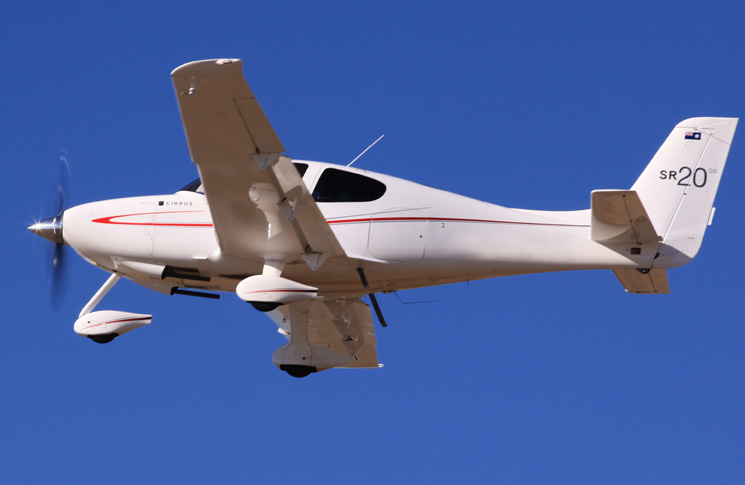Engineer Roger Alder discusses water damage and aircraft maintenance systems
Light aircraft are increasingly becoming engulfed in flood waters during catastrophic storms such as Cyclone Debbie in Queensland and Hurricane Harvey and now Irma in the US. Is a flood damaged aircraft automatically a write-off? How would you know?
Recent flooding at a small aircraft airport started me thinking about how to deal with the problem of the registered owner of a class B aeroplane who might rock up to the hangar doors towing, say, a Piper Cherokee with a dirty flood tide mark midway up the vertical fin, or someone who had just purchased a flood-damaged write-off from an insurance company.
Just what kind of maintenance action would be required (if any) to ensure it was airworthy? Somewhere in the back of my mind a picture of a large, black box with the word ‘Pandora’ stencilled on the lid floated silently past in murky brown flood water.
Never ever having done a post-flood inspection, or where to find one, I asked around and a colleague mentioned the Special Inspection section of the Piper Cherokee Maintenance Manual. It contains all the usual suspects, heavy landing/flight through turbulence and lightning strike inspections, and a post-flood inspection. Hold that thought.
Could I use it? I considered the options, starting with the key document, the Aircraft Log Book and the Log Book Statement, which usually identifies CASA Schedule 5.
The CAR regulations are ‘silent’ and therefore not helpful when it comes to ‘adding’ extra inspections or updated maintenance inspection tasks for an aircraft maintained to Schedule 5. It’s not that you can’t but its more that you probably won’t since doing the minimum mandated is commonly accepted unless in cases where it becomes obvious that the maintenance schedule is ‘no longer appropriate’ (CAR 42) for the aircraft’s continuing airworthiness.
However, when you consider that the aircraft’s continuing airworthiness is the responsibility of the registered operator/owner (CAR 41) then you might want to reconsider the need to look at those useful inspection tasks that the OEM has published for those ‘unscheduled’ (oops) type situations.
The other thing to consider with these ‘unscheduled’ maintenance events is that even with Schedule 5, you will be obligated under CAR 42V to ‘use’ those published maintenance instructions when an event such as flood is known to have happened by ‘ensuring that the maintenance is carried out in accordance with the applicable provisions of the aircraft’s approved maintenance data’.
If Schedule 5, plus heavy landing/overload/lightning strike is specified, then of course you have to do them, but a post-flood/immersion inspection may not be there.
On the other hand, if the LBS states, ‘Manufacturer’s Maintenance Program’ (CAR 42A) then I would argue that you are obliged to perform the appropriate inspections, including a post-flood inspection, if there is one.
As strange as it may seem, a post-flood (immersion) inspection is not a mandatory requirement for any aeroplane maintained in accordance with a CASA System of Maintenance (see CAR 1988 42L Systems of maintenance matters to be included).
Neither is there currently any CASA CAAP or AWB to advise you what a post-flood inspection might look like. There is, of course AWB 02-042 Issue 1—Corrosion inhibiting compounds and their effects on aircraft structural joints which says don’t go squirting your favourite water-displacing fluid in riveted structures because it will loosen up and fail, and AWB 51-008 Aircraft Tubular Steel Structures—Inspection, about corrosion inside welded tube structures. If water collects and rusts tubes from the inside out when they are kept ‘dry’, what can you expect if they go for a swim?
So, I sat down, fired up the internet and typed in ‘aircraft post-flood inspection’. Up popped the Federal Aviation Administration (FAA) ‘Basic Inspection Techniques/Practices’. Bingo!
I scrolled to ‘Post-flood Inspection’ and just one sentence blew the lid clean off Pandora’s Box, hinges and all: ‘Any parts that were totally submerged should be completely disassembled, thoroughly cleaned, dried and treated with a corrosion inhibitor.’ I could hear the whine of air drills taking out rivets to open sheet metal skin lap joints for cleaning and corrosion treatment. I saw the engine, flight controls, systems and undercarriage scattered over the hangar floor. The Piper Cherokee post-flood inspection reads pretty much the same.
The FAA 8083-30 Chapter 8 also includes heavy landing, flight through turbulence/excessive ‘G’ inspections and even a post-fire inspection (just in case anything is left) all of which, I understand, are to be used if not found in the aircraft maintenance data.
Although being new to the FAA regulations, going by the FAA 8083-30 Chapter 8 Inspection Guide, it seems that the FAA Annual Inspection check list is more comprehensive than our CASA Schedule 5, even when expanded by additional inspections in the log book statement. The FAA Annual Inspection seems to be a combination of both our old certificate of airworthiness (CofA) inspection which was done every 12 months, and the later in-depth major inspection which we used to do every three years.
The FAA Annual Inspection requires a detailed physical inspection of the aircraft every 100 hours/12 months, and includes a complete technical record (log books) survey and an audit of the aircraft against the Type Certificate Data Sheet (TCDS), to ensure the aeroplane meets Type Design. Title 14 of the code of Federal Regulation (14CFR) Part 91 Subpart E provides the basic requirements for the Annual/100-hour inspection, and a check list is found in Appendix D of 14 CFR Part 43.
Of course, FAA 8083-30 at first seems to have some sink holes. For example, suppose your aircraft is subjected to hailstones the size of a cricket ball (baseball for our international readers) so that the aeroplane now resembles a flattened golf ball with wings and a propeller at one end, there is no ‘Hail Damage’ Inspection.
While the CASA AWB 51-010 Assessment of Hail Damage provides excellent guidance and points to Cessna and Piper manufacturer’s data, where do you stop?
There will never be enough special inspections to meet all the unplanned events or environmental catastrophes available.
The very clever bit about the FAA CFR 14 Part 43 and Part 91 maintenance regulations is that they drive you to ensuring the aircraft meets type design or approved modified/repaired condition, and is both airworthy and serviceable before flight. This is, after all, the primary goal of all maintenance, but this approach is new to Australia. For example, if you ask the question, ‘Was immersing the airframe and engine in polluted flood water part of the manufacturing process?’ and if the answer is ‘no’, then it must be properly restored before further flight.
No wonder there appears to be a ground swell of owners and operators actively campaigning CASA to ditch current maintenance regulations and bring in the US Federal Aviation CFR 14 Maintenance Regulations.
Being utterly frustrated by the limitations of Schedule 5 in its present form and the subsequent embarrassing erosion of their aviation assets, there is an understandable drive to improve maintenance standards, including the freedom to perform necessary maintenance in accordance with the aircraft manufacturer’s instructions.
Before I go, hands up all owners of stressed metal airframes that just hosed out the mud and followed up with LPS and left it at that? I see. Oh well. Time will tell.






I think there is a reason there is no specific instructions. . Because it comes down to COMMON SENSE! You want yet another layer of unnecesary beurocrassy because you are concerened that you can’t figure out what might have been damaged by flood water or hail?
Perhaps CASA assumes anyone qualified to conduct aircraft maintenence is not a simpleton and can use their own judgement. Are you trying to prove them wrong?
Yeah……..Beurocrassy………
Beaurockcrazy …. CASA style !!!